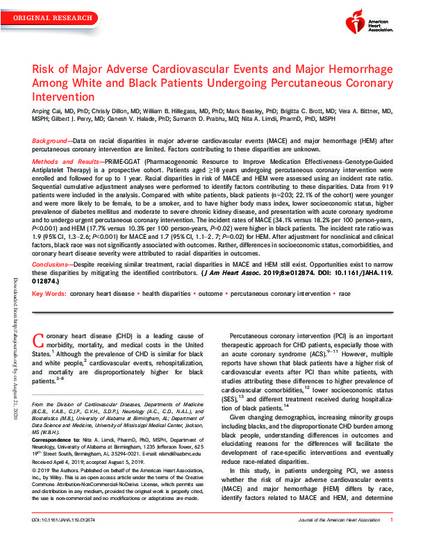
- coronary heart disease,
- health disparities,
- outcome,
- percutaneous coronary intervention,
- race
Background: Data on racial disparities in major adverse cardiovascular events (MACE) and major hemorrhage (HEM) after percutaneous coronary intervention are limited. Factors contributing to these disparities are unknown. Methods and Results: PRiME-GGAT (Pharmacogenomic Resource to Improve Medication Effectiveness–Genotype-Guided Antiplatelet Therapy) is a prospective cohort. Patients aged ≥18 years undergoing percutaneous coronary intervention were enrolled and followed for up to 1 year. Racial disparities in risk of MACE and HEM were assessed using an incident rate ratio. Sequential cumulative adjustment analyses were performed to identify factors contributing to these disparities. Data from 919 patients were included in the analysis. Compared with white patients, black patients (n=203; 22.1% of the cohort) were younger and were more likely to be female, to be a smoker, and to have higher body mass index, lower socioeconomic status, higher prevalence of diabetes mellitus and moderate to severe chronic kidney disease, and presentation with acute coronary syndrome and to undergo urgent percutaneous coronary intervention. The incident rates of MACE (34.1% versus 18.2% per 100 person-years, P < 0.001) and HEM (17.7% versus 10.3% per 100 person-years, P=0.02) were higher in black patients. The incident rate ratio was 1.9 (95% CI, 1.3–2.6; P < 0.001) for MACE and 1.7 (95% CI, 1.1–2. 7; P=0.02) for HEM. After adjustment for nonclinical and clinical factors, black race was not significantly associated with outcomes. Rather, differences in socioeconomic status, comorbidities, and coronary heart disease severity were attributed to racial disparities in outcomes. Conclusions: Despite receiving similar treatment, racial disparities in MACE and HEM still exist. Opportunities exist to narrow these disparities by mitigating the identified contributors.
Journal of the American Heart Association, v. 8, issue 22, art. e012874
Available at: http://works.bepress.com/ganesh-halade/69/